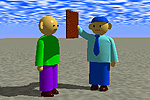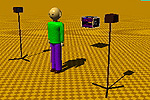Background of development
Coventional method of obstacle perception training in rehabilitation or education for the blind is that, in many case, trainee acquires it by listening real sound variation caused by existence of object (Fig. 1).

However, this method has problems that the beginners can hardly understand the sound variation, and they spend long time to acquire.
Yoshikazu Seki wondered if scientific, not experiential, training could be performed by taking account of mechanism of obstacle perception.
Outline of system
Yoshikazu Seki developed device that can reproduce ideal reflected sounds caused by object , using acoustical technologies. This device can reproduce sound variation caused by object more intelligibly than real situation. (Fig. 2)

This system was too huge and expensive to introduce for rehabilitation and education facilities. Yoshikazu Seki also developed simplified version so that they can introduce the system. (Fig. 3)

This system let the dream of scientific training come true.
Present status
The simplified version of Training System is now working in The College of National Rehabilitation Center for Persons with Disabilities, Japan for educational use.
Introduction of hardware such as Training System is still heavy load for rehabilitation and education facilities, even if it is simplified version. Therefore, providing audio software, that is made by recording the sound field reproduced by Training System on audio CD, was started from 2001.
References
- Yoshikazu SEKI,
Systematic Auditory Training of Obstacle Sense for the Visually Impaired by using Acoustical VR System,
Human-Computer Interaction (Proceedings of HCI International '99) 2 , 999-1003 (1999).
Funds of Research
This work was partly supported by Assistive Engineering for Participation of Aged Disabled Persons,
Special Co-ordination Funds for Promoting Science and Technology, 1996 - 1998, from Science and Technology Agency (STA), currently Ministry of Education, Culture, Sports, Science and Technology (MEXT), Japan.

 National Institute of Advanced Industrial Science and Technology (AIST), Japan
National Institute of Advanced Industrial Science and Technology (AIST), Japan